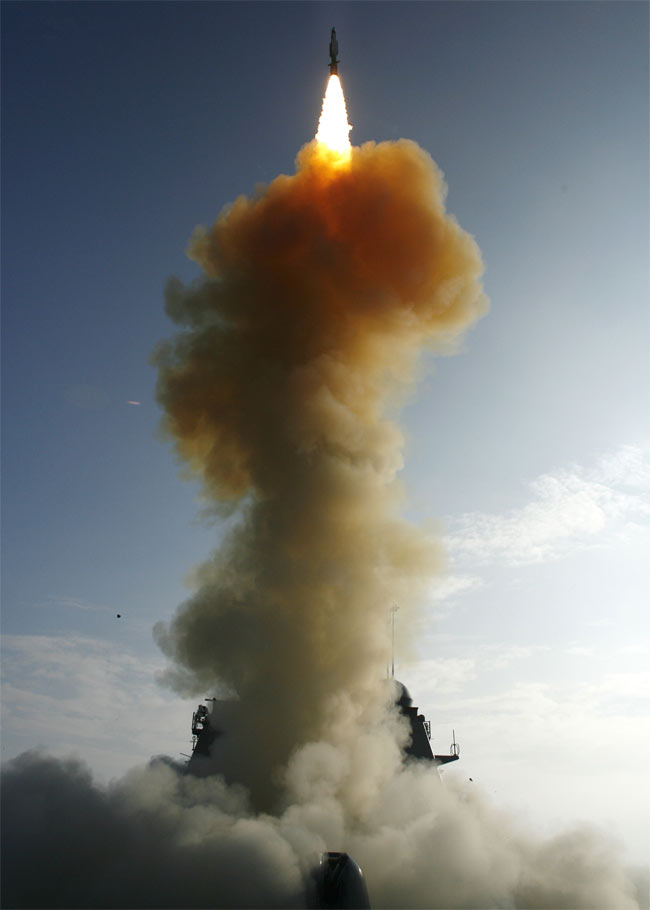Spysat Debris Delays New Satellite's Launch

Thisstory was updated at 3:34 p.m. EST.
The plannedFriday launch of a new U.S. spy satellite has been delayed by space debris fromlast week?s destruction of its disabled predecessor, the mission?s launchprovider said Wednesday.
Initiallyslated for a Feb. 29 liftoff from Vandenberg Air Force Base in California, theNational Reconnaissance Office?s classified NROL-28 reconnaissance spacecraftwill stand down for at least two weeks to avoid the orbiting remains of the destroyedUSA-193 satellite, the United Launch Alliance said in a mission update.
?This is aprecautionary measure to avoid possible debris from the satellite that wasintercepted on Feb. 20,? a spokesperson for ULA, which is overseeing the newsatellite?s launch atop an Atlas 5 rocket, said in a Wednesday mission hotlineupdate.
The U.S.Navy cruiser USS Lake Erie launchedan SM-3 missile from the Pacific Ocean on Feb. 20 to destroy the defunctUSA-193, a school bus-sized classified reconnaissance satellite that failedshortly after its December 2006 launch. The satellite?s demise was a safetymeasure to prevent its half-ton load of toxic hydrazine rocket fuel fromendangering people on Earth, Pentagon officials said.
As ofMonday, the military was tracking less than 3,000 pieces ofdebris, all smaller than a football in size, from 5,015 pounds (2,275kg) satellite?s destruction, Pentagon officials said. Left unattended, at leasthalf of the satellite was expected to survive reentry to rain down on Earthnext month.
?From thedebris analysis, we have a high degree of confidence the satellite's fuel tankwas destroyed and the hydrazine has been dissipated," said U.S. MarineCorps Gen. James Cartwright, vice chairman of the Joint Chiefs of Staff, inFeb. 25 statement.
Get the Space.com Newsletter
Breaking space news, the latest updates on rocket launches, skywatching events and more!
Thesatellite, which was also known as NROL-21, was destroyed about 153 miles (247 km) above Earth by a kinetic hit with a missilelaunched from a point northwest of Hawaii at 10:26 p.m. EST (0326 Feb. 21GMT).
Militaryofficials said Monday that the majority of the destroyed satellite?s debris has alreadyreentered the Earth?s atmosphere or will do so in the next few weeks. Therehave been no reports of any debris fragments surviving their fiery atmosphericreentry to impact the ground, they added.
Eagerskywatchers, however, did reportsightings of what appeared to be the dead satellite?s remains in orbit.
Last week,NASA space operations chief Bill Gerstenmaier said the civilian agency did not believethat debris from USA-193 would hinder the planned March 11 launch of theshuttle Endeavour to the International Space Station (ISS).
"Wedon't think it'll be a problem, but we'll continue to analyze it to make surethat it's not a problem or a concern to us," Gerstenmaiersaid on Feb. 20, just after the space shuttle Atlantis landed earlier thatday.
The agencyactivated a backup shuttle runway in California in addition to its primarylanding site at the Kennedy Space Center in Cape Canaveral, Fla., inorder to land Atlantis and its seven-astronaut crew as soon as possible and givethe U.S. military a clear shot at the ailing spy satellite. The shuttleultimately touched down in Florida after clear weather made its backup landingstrip unnecessary.
While theU.S. Navy had modified three SM-3 missiles to make the satellite shot, thespacecraft was successfully destroyed on the first attempt.
As ofMonday, the space surveillance systems of the U.S. Strategic Command werecontinuing to monitor the remaining satellite debris to track any future riskto ground or orbital object, military officials said.
- VIDEO: Successful Satellite Kill
- The Sky is Falling: The Most Memorable Pieces of Space Debris
- VOTE: Best Cosmic Duo to Destroy a Wayward Satellite
Join our Space Forums to keep talking space on the latest missions, night sky and more! And if you have a news tip, correction or comment, let us know at: community@space.com.

Tariq is the Editor-in-Chief of Space.com and joined the team in 2001, first as an intern and staff writer, and later as an editor. He covers human spaceflight, exploration and space science, as well as skywatching and entertainment. He became Space.com's Managing Editor in 2009 and Editor-in-Chief in 2019. Before joining Space.com, Tariq was a staff reporter for The Los Angeles Times covering education and city beats in La Habra, Fullerton and Huntington Beach. In October 2022, Tariq received the Harry Kolcum Award for excellence in space reporting from the National Space Club Florida Committee. He is also an Eagle Scout (yes, he has the Space Exploration merit badge) and went to Space Camp four times as a kid and a fifth time as an adult. He has journalism degrees from the University of Southern California and New York University. You can find Tariq at Space.com and as the co-host to the This Week In Space podcast with space historian Rod Pyle on the TWiT network. To see his latest project, you can follow Tariq on Twitter @tariqjmalik.









